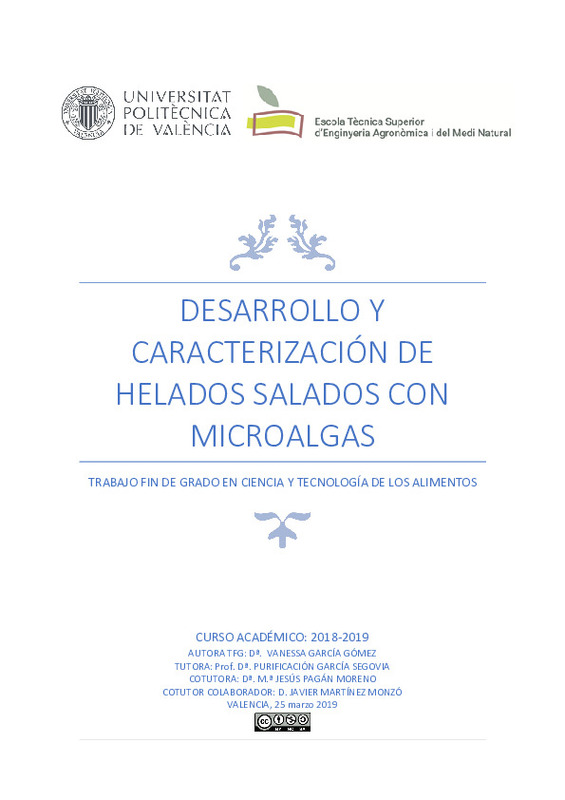|
Resumen:
|
[ES] El helado es un alimento tradicionalmente de sabor dulce, que se consume en estado
congelado. Para este proyecto, se ha decidido romper los esquemas del mercado elaborando
helados salados, con la particularidad de ...[+]
[ES] El helado es un alimento tradicionalmente de sabor dulce, que se consume en estado
congelado. Para este proyecto, se ha decidido romper los esquemas del mercado elaborando
helados salados, con la particularidad de añadirles microalgas que son una fuente de vitaminas
y minerales naturales y sabores vegetales.
Se caracterizó el producto mediante la determinación de una serie de parámetros de
calidad, como el overrun, el tiempo de caída de la primera gota y el porcentaje de derretimiento.
Además, se analizaron propiedades fisicoquímicas como el pH, densidad y el color, y parámetros
texturales y sensoriales.
Se ensayaron con distintas formulaciones y combinaciones de proporciones de
ingredientes hasta conseguir tres sabores distintos y seis prototipos finales, de los cuales tres
incorporan Spirulina y tres Chlorella.
Los distintos prototipos de helados conseguidos en el presente proyecto contienen
propiedades refrescantes al incorporar verduras y frutas con sabores muy actuales, en sintonía
con el vigente estilo de vida. Una sociedad que cada vez incorpora más verduras y frutas en su
alimentación habitual.
Los prototipos elaborados presentaron una textura suave en boca, con la cantidad justa
de grasa para mantener su estructura el tiempo suficiente para ser consumido sin descongelar.
Los colores de los distintos prototipos se ven influenciados por el tipo de microalga utilizada,
siendo más verdosos-azules los elaborados con Spirulina y más verdes-amarillos los elaborados
con Chlorella.
Finalmente, tras el análisis sensorial de los distintos prototipos se determinó una buena
aceptación del producto, pero con una baja intencionalidad de compra, como suele ocurrir con
muchos productos con innovaciones radicales.
[-]
[EN] Ice cream is a traditionally sweet-tasting food, which is consumed in a frozen state. For
this project, it has been decided to break the market schemes by making salty ice creams, with
the particularity of adding ...[+]
[EN] Ice cream is a traditionally sweet-tasting food, which is consumed in a frozen state. For
this project, it has been decided to break the market schemes by making salty ice creams, with
the particularity of adding microalgae that are a source of natural vitamins and minerals and
vegetable flavors.
The product was characterized by the determination of a series of quality parameters,
such as overrun, first dripping time and melting rate. In addition, physicochemical properties
such as pH, density and color, and textural and sensory parameters were analyzed.
They were tested whit different formulations and combinations of ingredient
proportions until achieving three different flavors and six final prototypes, of which three
incorporate Spirulina and three Chlorella.
The different ice cream prototypes obtained in this project contain refreshing properties
by incorporating vegetables and fruits with very current flavors, in line with the prevailing
lifestyle. A society that increasingly incorporates more vegetables and fruits into their usual diet.
The elaborated prototypes presented a smooth texture in the mouth, with just the right
amount of fat to maintain its structure long enough to be consumed without thawing. The colors
of the different prototypes are influenced by the type of microalga used, being greenish-blue
those made with Spirulina and more green-yellow those made with Chlorella.
Finally, after the sensory analysis of the different prototypes, a good acceptance of the
product was determined, but with a low intentionality of purchase, as often happens with many
products with radical innovations.
[-]
|








